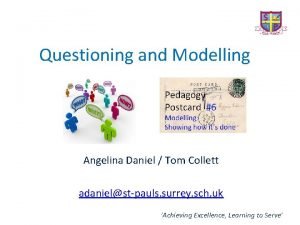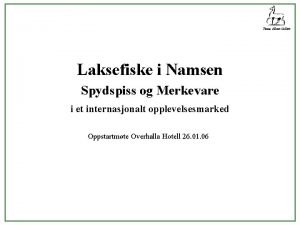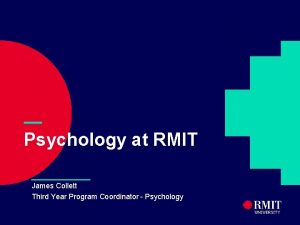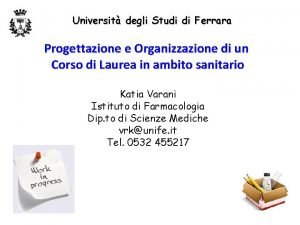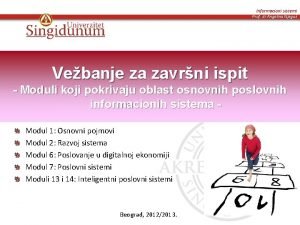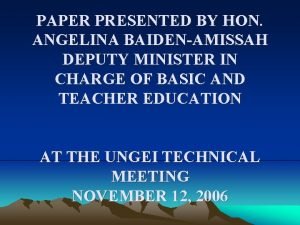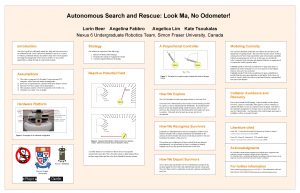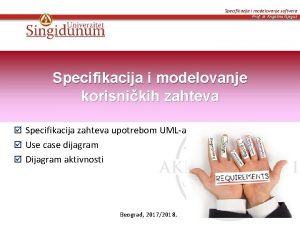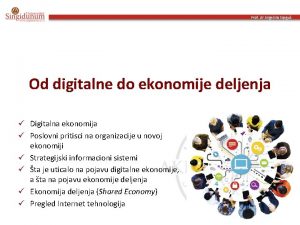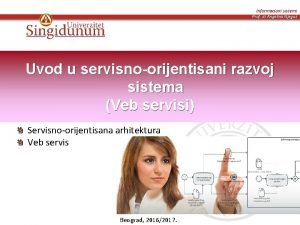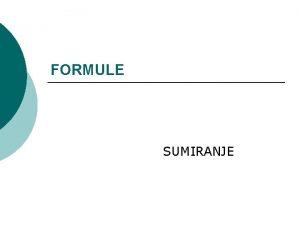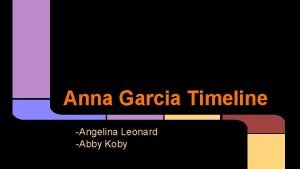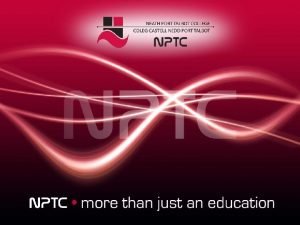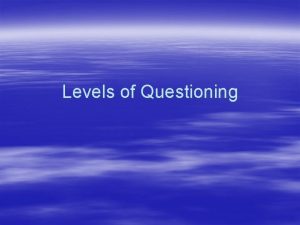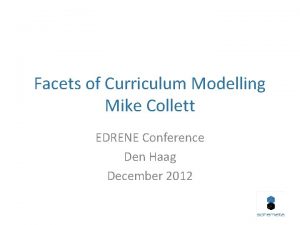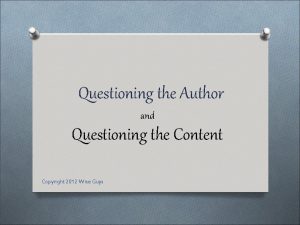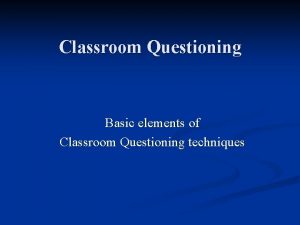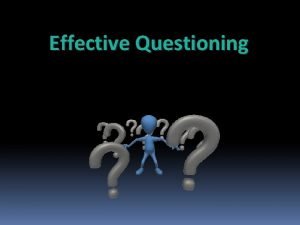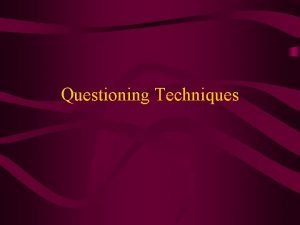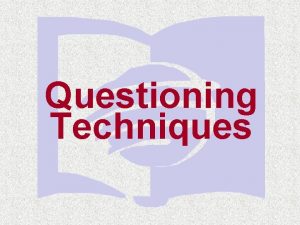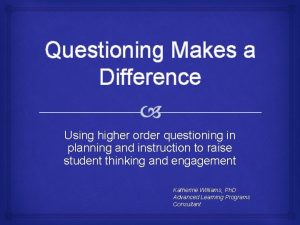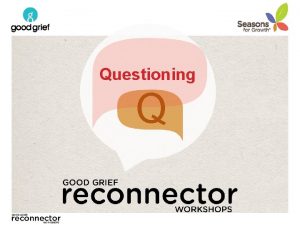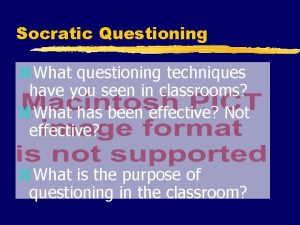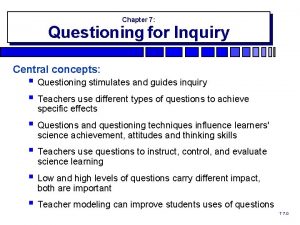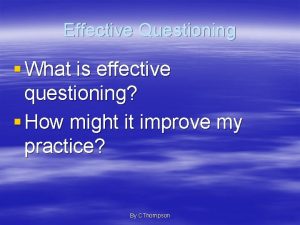Questioning and Modelling Angelina Daniel Tom Collett adanielstpauls



























- Slides: 27

Questioning and Modelling Angelina Daniel / Tom Collett adaniel@st-pauls. surrey. sch. uk ‘Achieving Excellence, Learning to Serve’

Objectives • To understand the what makes effective questioning and the concept of modelling • To recognise the different styles of questioning and modelling • To analyse how questioning and modelling can be effective in developing metacognition ‘Achieving Excellence, Learning to Serve’

Why ? • Why do we question students? • What do we hope to achieve? • How can we model through our questioning? How many questions does a teacher ask each lesson / day / week / ½ term / year? • 10 / 50 / 250 / 1500 / 9000 • 20 / 100 / 500 / 3000 / 18000 ‘Achieving Excellence, Learning to Serve’

Why Question? - To check students’ recall To formatively assess – to gauge what students know/ don’t know; To drive learning forwards; To promote engagement and positive behaviour; To model curiosity/ encourage students to become questioners themselves; To promote higher-order thinking and meta-cognition skills; To break up teacher talk – questions allow for student input; To offer model language or ways of thinking; To challenge students and further extend their learning experiences; To improve students’ speaking, listening, and collaboration skills. ‘Achieving Excellence, Learning to Serve’

Most Effective Questioning Everyone has an opportunity to answer Learners hear how others are thinking Teachers gain info about thinking and learning Learners have time to consider their answers Learners feel safe to answer Learners have time to reflect /discuss/follow up their answers • Questions stimulate thinking/more questions • • • What would that look like in the classroom? How could you make it work? Discuss ‘Achieving Excellence, Learning to Serve’

Questions, Questions What questions could you ask to encourage a student to elaborate or develop their answer. Can you think of 3? Note them down ‘Achieving Excellence, Learning to Serve’

Verbal questioning in feedback That’s interesting, what makes you say that? That’s true, but why do you think that is? Is there a different way to say the same thing? Can you give an example of where that happens? Can you explain how you worked that out? What is the evidence that supports that suggestion? Does anyone agree with that? Why? Does anyone disagree? What would you say instead? Why is that different? But what’s the reason for that? And how is that connected to the first part? How did you know that? What made you think of that? Where did that idea come from? Is that always true or just in this example? Is that a direct cause of the effect or is it just a coincidence, a correlation? Not sure if that’s quite right… have another go… is that what you meant? That’s the gist of it… but if could you say that more fluently? ‘Achieving Excellence, Learning to Serve’

Classroom chat that surfaces the learning • • • How did you do that? How else could you have done that? Who did that a different way? Which are the tricky bits? What’s tricky about them? What could you do when you are stuck on that? What would have made that easier for you? What else do you know that might help? How could you help someone else do that? How could I have taught that better? Where else could you use that? How could you make that harder for yourself? Professor Guy Claxton ‘Achieving Excellence, Learning to Serve’

Tracking Questions Annotated seating plan ‘Achieving Excellence, Learning to Serve’

Metacognition What is Metacognition? How does it link to questioning? Think, pair, share Metacognition - Being explicitly aware of how you learn and actively monitoring your own learning. Learning from the process to help you reach your goal. Getting students to self reflect and ask themselves and others questions will help them improve, develop and reach their goals. ‘Achieving Excellence, Learning to Serve’

Classroom chat that surfaces the learning • • • How did I do that? How else could I have done that? Can I learn from anyone who did it a different way? Which are the tricky bits? What’s tricky about them? What could I do when I am stuck? What would have made that easier for me? What else do I know that might help? How could I help someone else do that? How could the teacher have explained that better? Where else could I use this? How could I make this harder for myself? Professor Guy Claxton ‘Achieving Excellence, Learning to Serve’

Metacognition Phases Planning Reflection Evaluating Monitoring ‘Achieving Excellence, Learning to Serve’

How am I going to approach this? What strategies and resources am I going to use? Planning What’s going to be tricky? What will I be good at? What do I need to do/know to overcome any difficulties? How can I activate prior learning to help me? Can I use any strategies that I have used before that have worked well? ‘Achieving Excellence, Learning to Serve’

How am I going to approach this? What strategies and resources am I going to use? What’s going to be tricky? What will I be good at? What do I need to do/know to overcome any difficulties? How can I activate prior learning to help me? Can I use any strategies that I have used before that have worked well? Planning How is this going? Is my approach working? Do I need to change anything? What have I been asked to do? Do I need to think differently? What are my strengths? What are my weaknesses? How did I do? What went well? What didn’t go well? What shall I do next time? What have I learnt from doing this task? How will I adapt my planning for next time? Do I need to improve my self-monitoring Monitoring Evaluating ‘Achieving Excellence, Learning to Serve’

How is this going? Is my approach working? Monitoring Do I need to change anything? What have I been asked to do? Do I need to think differently? What are my strengths? What are my weaknesses? ‘Achieving Excellence, Learning to Serve’

How did I do? What went well? Evaluating What didn’t go well? What shall I do next time? What have I learnt from doing this task? How will I adapt my planning for next time? Do I need to improve my self-monitoring? ‘Achieving Excellence, Learning to Serve’

Self-question throughout the task. What have I been asked to do? How am I going to approach this? What strategies am I going to use? What’s going to be tricky? What do I need to do to overcome any difficulties? Can I use any strategies that I have used before? Planning Reflection How did I do? What went well? What didn’t go well? What shall I do next time? What have I learnt from doing this task? Evaluating How is this going? Is my approach working? Do I need to change anything? Do I need to think differently? Monitoring ‘Achieving Excellence, Learning to Serve’

Modelling Explore one way that you have…. • Experienced modelling during your own education; • Modelled a task for your students when teaching. How can questioning be used in modelling effectively? How does modelling link to metacognition? Think, pair, share ‘Achieving Excellence, Learning to Serve’

Task Modelling Task modelling occurs when the teacher demonstrates a task students will be expected to do on their own. This type of modelling would precede activities such as science experiments, foreign language communication, physical education tasks, and solving mathematical equations. This strategy is used so that students can first observe what is expected of them, and so that they feel more comfortable in engaging in a new task or activity. ‘Achieving Excellence, Learning to Serve’

Meatacongnitive Modelling Metacognitive modelling demonstrates how to think in lessons that focus on interpreting information and data, analysing statements, and making conclusions about what has been learned. This type of modelling would be particularly useful in a maths class when teachers go through multiple steps to solve a problem. Example - Teachers would talk through their own thought process while they do the problem on a board or collaboratively on MWBs. “This thinking-out-loud approach, in which the teacher plans and then explicitly articulates the underlying thinking process… should be the focus of teacher talk. ” – Bandura This type of modelling can also be done in a reading lesson while the teacher asks rhetorical or actual questions or makes comments about how to anticipate what is coming next in a story. ‘Achieving Excellence, Learning to Serve’

Scaffolding Modelling When using modelling as a scaffolding technique, teachers must consider students’ position in the learning process. Teachers first model the task for students, and then students begin the task and work through the task at their own pace. In order to provide a supportive learning environment for students who have additional needs or English as an additional language, teachers will probably need to model the task multiple times. ‘Achieving Excellence, Learning to Serve’

Student – centred Modelling Often the most effective type of modelling in terms of student engagement, teachers ask students to model a performance, task or a thought processes. In student-centred modelling, teachers engage students who have mastered specific concepts or learning outcomes in the task of modelling for their peers. This type of modelling makes the class less “teacher-centred, ” which, in some cases, provides a more supportive learning environment for students Examples • Use an app like ‘scannable’ to take work and display on the screen immediately (Apple TV/I Pads helpful here). • Could use a visualiser to show work in books and show its merits • Walking Talking Mark can be done in front of the class with their own work • Collaborative marking ‘Achieving Excellence, Learning to Serve’

Lambert and Balderstone (2010) Teacher modelling/demonstration Joint activity Scaffolding activity Independent activity ‘Achieving Excellence, Learning to Serve’

Top Tips for modelling 1. Plan your modelling Spending a short time thinking about ‘how’ you will model a concept or outcome can really improve your self-confidence. Sometimes, the simplest of concepts are the hardest to model! 2. Model live Providing a live model is going to show pupils the process, rather than the outcome. 3. Go with the flow Know that modelling too quickly or too slowly will impact how well your pupils proceed with the learning. Scan the room to decide if you ought to speed up or slow down your modelling. Regularly check the learning! 4. Exploit modelling throughout the lesson Use the input to model to the whole class; adapt the learning time to model to those who need further instruction and before the end of the lesson, provide pupils with the chance to model their learning to each other. 5. Talk-through your modelling Talking over the top of your modelling allows pupils to hear your thinking. Sometimes you’re actually modelling how to think about a process, rather than the process itself. 6. Simplify Break down longer processes by modelling one part at a time. 7. Use worked examples Provide a worked example to help key pupils. ‘Achieving Excellence, Learning to Serve’

Bringing it all together ‘Achieving Excellence, Learning to Serve’

Take Away… • Write down 2 things you are going to take away from today’s session. • In a fortnight when you have tried them out, evaluate their effectiveness with your mentor. ‘Achieving Excellence, Learning to Serve’

Questions? ‘Achieving Excellence, Learning to Serve’
 Tom collett
Tom collett Firma albert collett
Firma albert collett Kelly collett
Kelly collett Lisa collett
Lisa collett Rmit bp154
Rmit bp154 What does the bible symbolize in the devil and tom walker
What does the bible symbolize in the devil and tom walker Sarah and angelina grimke apush
Sarah and angelina grimke apush Tomtom go 910 update
Tomtom go 910 update Valmon unife
Valmon unife Angelina what
Angelina what Angelina
Angelina Angelina njegus
Angelina njegus Angelina jolie was born
Angelina jolie was born Angela varone
Angela varone Angelina lu
Angelina lu Aristides de sousa mendes angelina ribeiro
Aristides de sousa mendes angelina ribeiro Unset message angelina
Unset message angelina Angelina baiden-amissah
Angelina baiden-amissah Golden ratio human body
Golden ratio human body Donna angelina
Donna angelina Angelina fabbro
Angelina fabbro Angelina njegus
Angelina njegus Angelina njegus
Angelina njegus Angelina njegus
Angelina njegus Angelina pillai
Angelina pillai Sumiranje
Sumiranje Anna garcia timeline
Anna garcia timeline Tom brennan girlfriend
Tom brennan girlfriend
